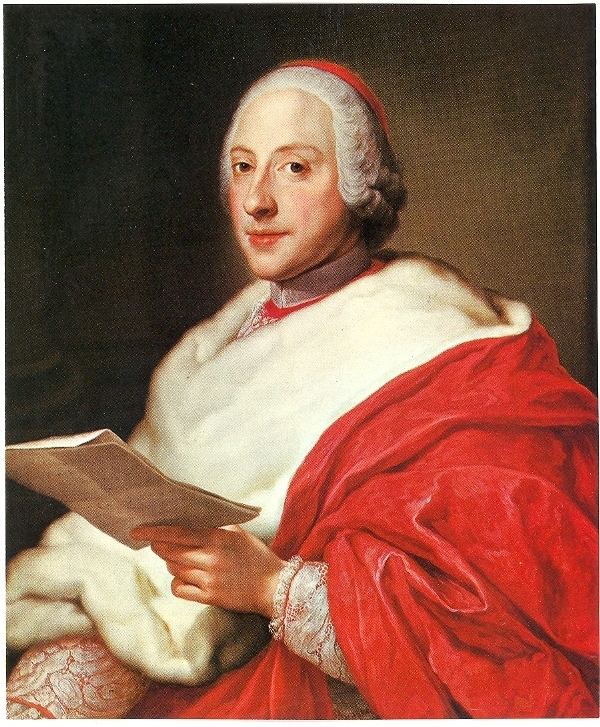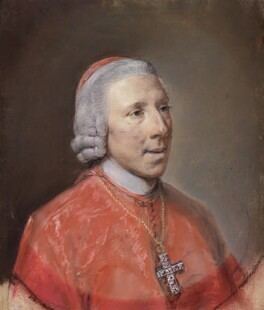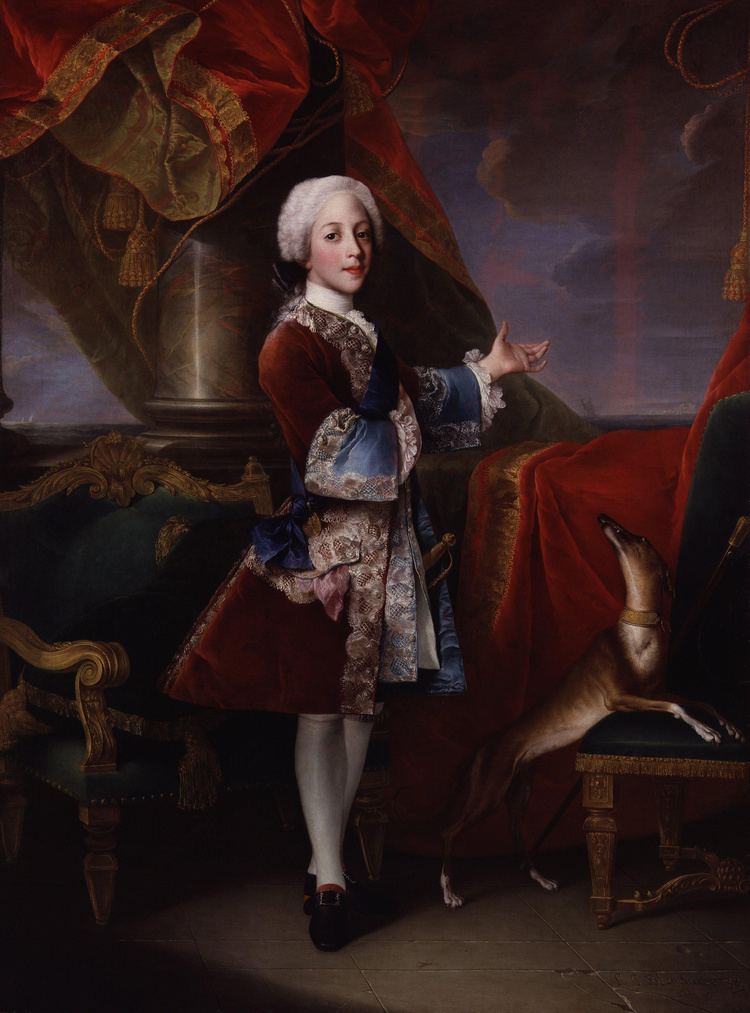Installed 13 July 1761 Term ended 13 July 1807 | Name Henry Stuart Appointed 13 July 1761 Siblings Charles Edward Stuart | |
 | ||
Parents Maria Clementina Sobieska, James Francis Edward Stuart Cousins Marie Louise de La Tour d'Auvergne, Godefroy de La Tour d'Auvergne Grandparents James II of England, Mary of Modena, James Louis Sobieski, Countess Palatine Hedwig Elisabeth of Neuburg Similar People Charles Edward Stuart, James Francis Edward S, Maria Clementina Sobieska, James II of England, Mary of Modena | ||
Rare 1899 jacobite biography of henry benedict stuart cardinal duke of york
Henry Benedict Thomas Edward Maria Clement Francis Xavier Stuart, Cardinal Duke of York (6 March 1725 – 13 July 1807) was a Roman Catholic Cardinal, as well as the fourth and final Jacobite heir to claim the thrones of England, Scotland, France, and Ireland publicly. Unlike his father, James Francis Edward Stuart, and brother, Charles Edward Stuart, Henry made no effort to seize the throne. After Charles's death in January 1788 the Papacy did not recognise Henry as the lawful ruler of England, Scotland, and Ireland, but referred to him as the Cardinal Duke of York.
Contents
- Rare 1899 jacobite biography of henry benedict stuart cardinal duke of york
- What is Henry Benedict Stuart Explain Henry Benedict Stuart Define Henry Benedict Stuart
- Early life
- French Revolution and later life
- Personal relationships
- Legacy
- Titles as cardinal
- Arms
- References
He spent his life in the Papal States and had a long career in the clergy of the Roman Catholic Church, rising to become the Dean of the College of Cardinals and Cardinal-Bishop of Ostia and Velletri. At the time of his death he was (and still is) one of the longest serving Cardinals in the Church's history.
In his youth, Henry's father made him Duke of York (in the Jacobite Peerage), and it was by this title that he was best known. Upon the death of his brother in 1788 Henry became known by Jacobites, and within his personal entourage, as Henry IX of England and Ireland, and I of Scotland, although publicly he referred to himself as Cardinal-Duke of York nuncupatus.

What is Henry Benedict Stuart?, Explain Henry Benedict Stuart, Define Henry Benedict Stuart
Early life

Henry was born in exile at the Palazzo Muti in Rome on 6 March 1725 and baptized on the same day by Pope Benedict XIII, 37 years after his grandfather James II and VII lost the throne, and ten years after his father's failed attempt to regain it. His father was James Francis Edward Stuart, known to his opponents as "the Old Pretender". His mother was the Princess Maria Klementyna Sobieska, granddaughter of the Polish King and Lithuanian Grand-Duke, John III Sobieski.

Henry went to France in 1745 to help his brother, Prince Charles Edward Stuart ("Bonnie Prince Charlie", or "the Young Pretender") prepare the Jacobite rising of 1745. After its defeat, Henry Stuart returned to Italy. On 30 June 1747 Pope Benedict XIV conferred him with tonsure and created him Cardinal-Deacon of S. Maria in Portico in a special consistory held on the 3 July 1747. On 27 August 1747 he was promoted to the four minor orders by the Pope. He received the subdiaconate on 18 August 1748 and diaconate on 25 August 1748. He was ordained priest on 1 September 1748 and consecrated titular Archbishop of Corinth on 2 October 1758.
He was advanced to the order of Cardinal Priest in 1748, maintaining title to S. Maria in Portico. In 1752 he transferred to the titulus of Ss. XII Apostoli. He was made Cardinal-Bishop of Frascati on 13 July 1761, and eventually succeeded to the See of Ostia and Velletri on his appointment as Dean of the Sacred College of Cardinals on 26 September 1803. He lived and worked in Frascati for many years, descending each afternoon in his carriage to Rome, where his position as vice-chancellor entitled him to the Palazzo della Cancelleria.
His revenues from the many ecclesiastical preferments he enjoyed were enormous. His income from abbeys and other pluralities in Flanders, Spain, Naples and France amounted to 40,000 Pounds in British money at the time. He also held sinecure benefices yielding revenues in Spanish America. He owned territory in Mexico, which contributed largely to his income.
Henry was the last claimant to the British throne to touch for the King's Evil.
French Revolution and later life
At the time of the French Revolution, he lost his French Royal benefices and sacrificed many other resources to assist Pope Pius VI. This, in addition to the seizure of his Frascati property by the French, caused him to descend into poverty. The British Minister in Venice arranged for Henry to receive an annuity of £4,000 from King George III of Great Britain. Although the British government represented this as an act of charity, Henry and the Jacobites considered it to be a first installment on the money which was legally owed to him. (For many years the British government had promised to return the English dowry of his grandmother, Mary of Modena, but never did so.)
Henry returned to Frascati in 1803. In September of that year he became the Dean of the College of Cardinals and hence Cardinal Bishop of Ostia and Velletri, though he still lived in the episcopal palace at Frascati. He died there on 13 July 1807, aged 82.
Personal relationships
Historians have drawn upon contemporary perceptions to explore the suggestion that Henry was homosexual. These accounts include the writings of Hester Lynch Thrale (1741–1821), and the diplomat and writer Giuseppe Gorani (1740–1819). Gorani admitted to having gathered evidence insufficient to confirm his suspicions either way, but drew attention to the number of handsome clerics that were to be found in Henry's palace. The historian Andrew Lang alluded to James's comment that his younger son would never marry although many marriages had been planned for him.
The writer Gaetano Moroni provides the lengthiest account of Henry's close attachment with his majordomo Monsignor Giovanni Lercari (1722–1802), whom Henry was said to have "loved beyond measure". This closeness led to serious tensions between the cardinal and his father who in 1752 eventually tried to have Lercari dismissed from service and sent from Rome. Henry reacted by attempting to separate his household finances from those of his father, and refused himself to return to Rome from Bologna without Lercari by his side. A public scandal was only narrowly avoided after the personal intervention of Pope Benedict XIV who acted as peace-maker. It was agreed that Lercari would leave the household and due to Henry's influence was later made Archbishop of Genoa.
Things became easier after the death of James in 1766. From 1769 onwards Henry remained close to Monsignor Angelo Cesarini, a nobleman from Perugia, who thanks to Henry's protection, won various honours, was made canon of the cathedral in Frascati, and finally in 1801 became Bishop of Milevi. When Henry died, Cesarini was still at his side, as he had been for 32 years. Cesarini was later buried in the church of Santa Maria in Vallicella.
Caution should nevertheless be given against assuming any active sexual relationships, even if they may have had a romantic element, because equally clear in contemporary sources is York's horror of all impropriety.
Legacy
Under his will, which he signed as "Henry R", he was succeeded in all his claimed British rights by his nearest blood-relative and friend, Charles Emmanuel IV of Sardinia. Charles neither asserted or renounced his Jacobite claims, like his successors. Charles Emmanuel and the following Kings of Sardinia, eventually Kings of Italy, had other vital interests in their Italian environment to which championing a hopeless cause in Britain would have been detrimental.
Contrary to popular belief, he did not leave the Crown Jewels to the Prince of Wales, afterwards George IV of the United Kingdom. All his property was entrusted to Monsignor Angelo Cesarini, for distribution. Cesarini sent the Prince of Wales several jewels from Henry's private collection. These included a "Lesser George" (thought to have been worn by Charles I at his execution, and now at Windsor Castle) and a St Andrew's Cross (now at Edinburgh Castle), which are insignia of the orders of the Garter and the Thistle, and also a ruby ring. Even so, the act of sending them to the Hanoverian Prince of Wales should under no circumstances be construed as constituting an effective, even if not formal, renounciation of the Jacobite claim.
Henry Benedict, his brother, his father and his mother are buried in the crypt of St. Peter's Basilica in the Vatican. There is a monument to the Royal Stuarts on one of the columns in the basilica proper, designed by Antonio Canova. The monument was originally commissioned by Monsignor Angelo Cesarini, executor of Henry Benedict's estate. Among the subscribers, curiously, was King George IV, who (once the Jacobite threat to his throne had ended with Henry Benedict's death became an admirer of the Stuart legend.
The monument was restored within living memory, at the expense of the late Queen Elizabeth the Queen Mother.
Titles as cardinal
During his life, Cardinal Stuart was assigned the following Diaconia and Tituli:
In March 1774 he became Sub-dean, and on 15 September 1803 – Dean of the Sacred College of Cardinals.
He was a cardinal elector in the papal conclaves of 1758, 1769, 1774–75 and 1799–1800.
Arms
During the pretence of his father and brother, Henry claimed a coat of arms consisting of those of the kingdom, differenced by a crescent argent or white crescent.
